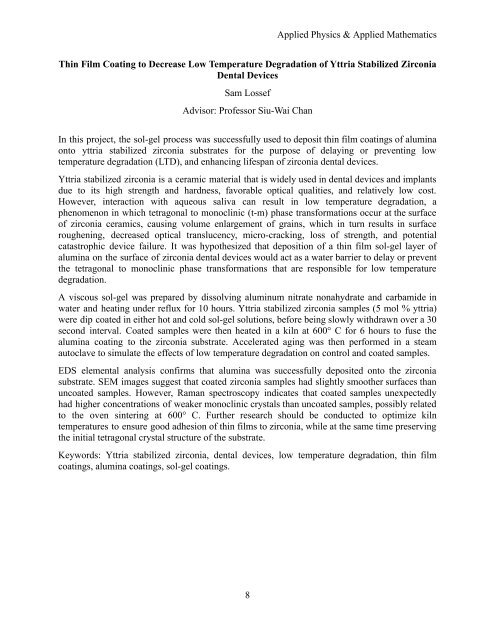You also want an ePaper? Increase the reach of your titles
YUMPU automatically turns print PDFs into web optimized ePapers that Google loves.
Applied Physics & Applied Mathematics<br />
Thin Film Coating to Decrease Low Temperature Degradation of Yttria Stabilized Zirconia<br />
Dental Devices<br />
Sam Lossef<br />
Advisor: Professor Siu-Wai Chan<br />
In this project, the sol-gel process was successfully used to deposit thin film coatings of alumina<br />
onto yttria stabilized zirconia substrates for the purpose of delaying or preventing low<br />
temperature degradation (LTD), and enhancing lifespan of zirconia dental devices.<br />
Yttria stabilized zirconia is a ceramic material that is widely used in dental devices and implants<br />
due to its high strength and hardness, favorable optical qualities, and relatively low cost.<br />
However, interaction with aqueous saliva can result in low temperature degradation, a<br />
phenomenon in which tetragonal to monoclinic (t-m) phase transformations occur at the surface<br />
of zirconia ceramics, causing volume enlargement of grains, which in turn results in surface<br />
roughening, decreased optical translucency, micro-cracking, loss of strength, and potential<br />
catastrophic device failure. It was hypothesized that deposition of a thin film sol-gel layer of<br />
alumina on the surface of zirconia dental devices would act as a water barrier to delay or prevent<br />
the tetragonal to monoclinic phase transformations that are responsible for low temperature<br />
degradation.<br />
A viscous sol-gel was prepared by dissolving aluminum nitrate nonahydrate and carbamide in<br />
water and heating under reflux for 10 hours. Yttria stabilized zirconia samples (5 mol % yttria)<br />
were dip coated in either hot and cold sol-gel solutions, before being slowly withdrawn over a 30<br />
second interval. Coated samples were then heated in a kiln at 600° C for 6 hours to fuse the<br />
alumina coating to the zirconia substrate. Accelerated aging was then performed in a steam<br />
autoclave to simulate the effects of low temperature degradation on control and coated samples.<br />
EDS elemental analysis confirms that alumina was successfully deposited onto the zirconia<br />
substrate. SEM images suggest that coated zirconia samples had slightly smoother surfaces than<br />
uncoated samples. However, Raman spectroscopy indicates that coated samples unexpectedly<br />
had higher concentrations of weaker monoclinic crystals than uncoated samples, possibly related<br />
to the oven sintering at 600° C. Further research should be conducted to optimize kiln<br />
temperatures to ensure good adhesion of thin films to zirconia, while at the same time preserving<br />
the initial tetragonal crystal structure of the substrate.<br />
Keywords: Yttria stabilized zirconia, dental devices, low temperature degradation, thin film<br />
coatings, alumina coatings, sol-gel coatings.<br />
8








